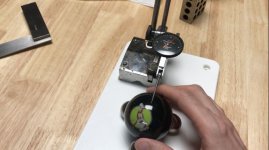Don't make the resolution of your inspection tools too fine. :wink:

If you wanna drive yourself nuts, this unit indicates to 10 millionths.
I use it for things like comparing dowels for inspection set ups, piston pins for roundness, etc. Can certainly do ball bearings.
Assume your 3 posts will be ball bearings? They are incredibly close tolerance.
Though if careful not to rotate/move them between inspections, it wouldn't matter.
smt

If you wanna drive yourself nuts, this unit indicates to 10 millionths.
I use it for things like comparing dowels for inspection set ups, piston pins for roundness, etc. Can certainly do ball bearings.
Assume your 3 posts will be ball bearings? They are incredibly close tolerance.
Though if careful not to rotate/move them between inspections, it wouldn't matter.
smt
![CropperCapture[61].jpg CropperCapture[61].jpg](https://forums.azbilliards.com/data/attachments/412/412888-cbdb1dc94aae3b12a320e3d46cae49c4.jpg?hash=y9sdyUquOx)
